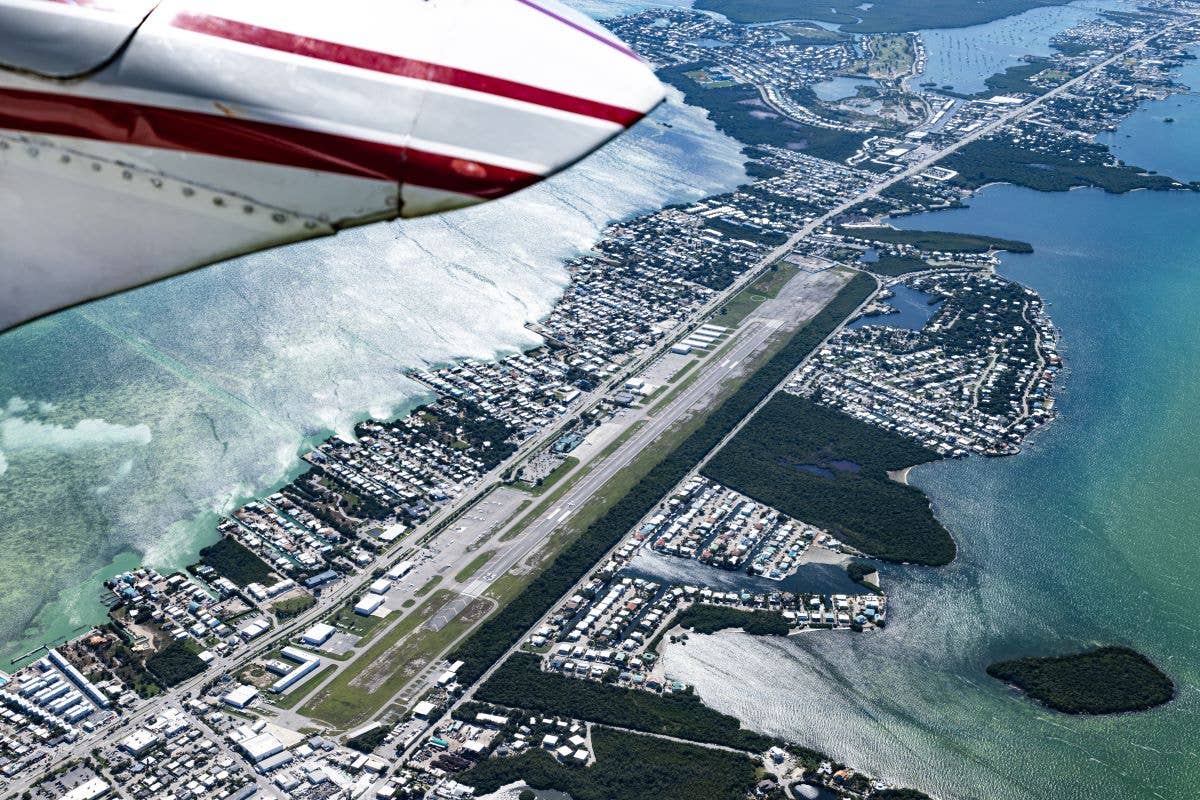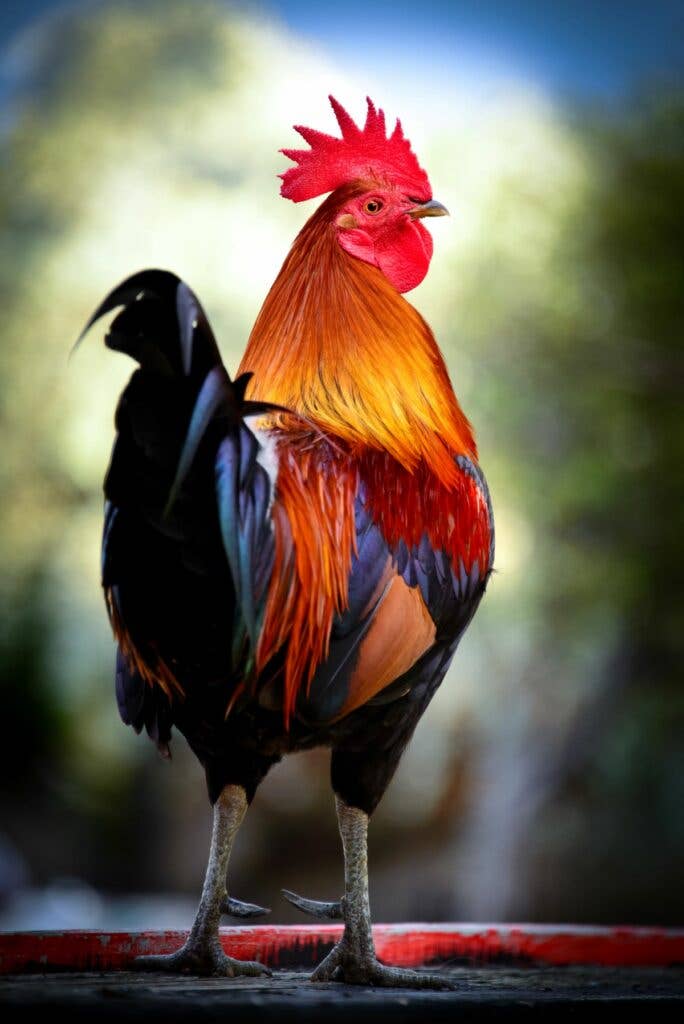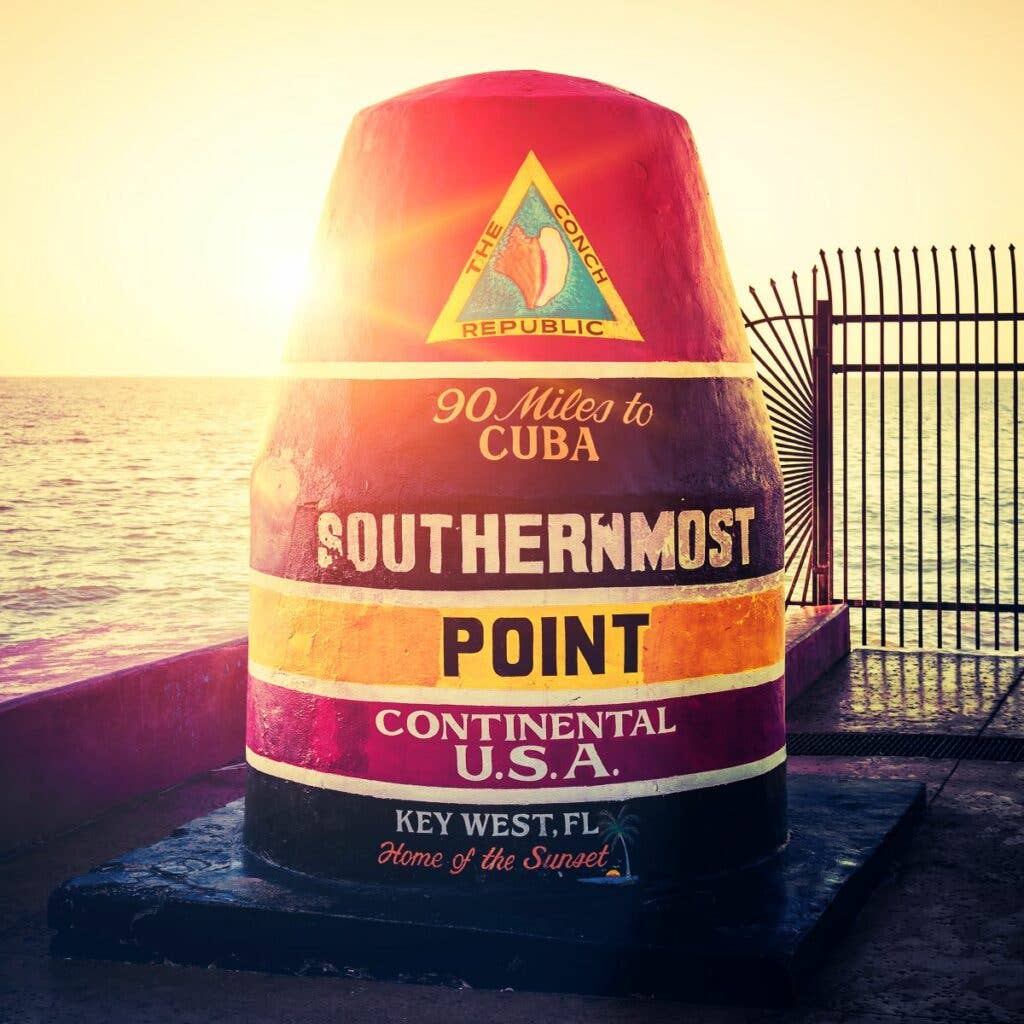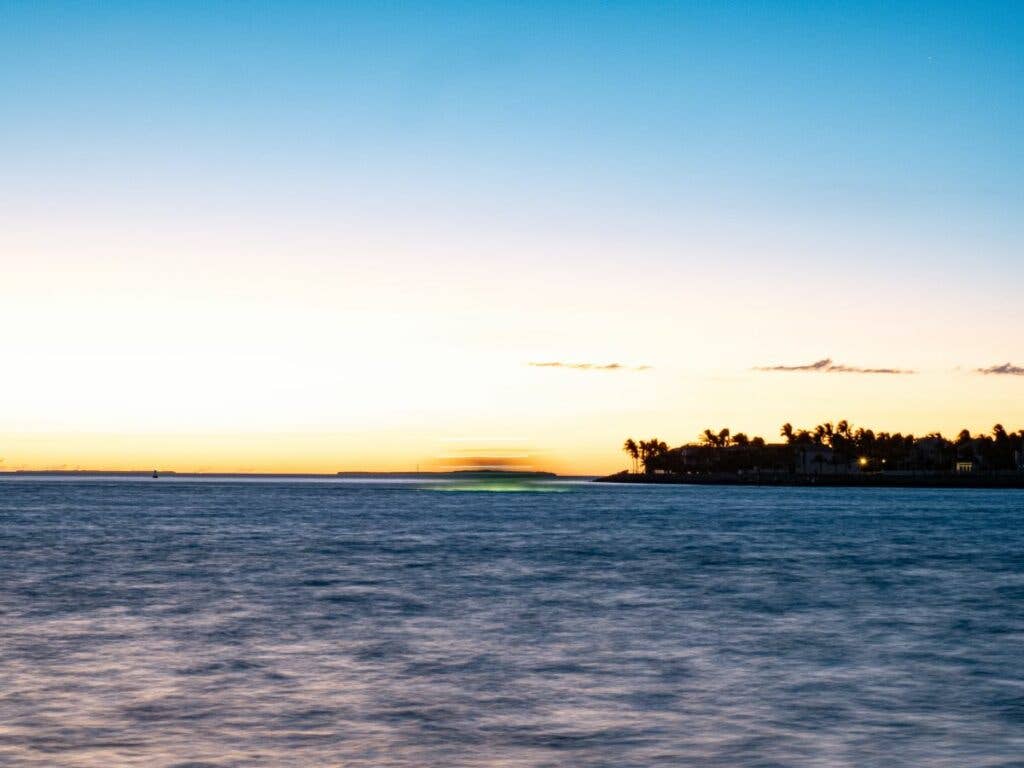Bucket List: Journey to the Keys
The island chain beckons, extending Florida’s reach into the Caribbean.

A pilot’s view of Marathon Key [Credit: Jim Barrett]
The ocean takes on a range of colors as you approach it from the tangle of land and water composing Florida’s southernmost end. The tones run from steel gray to cerulean blue to baby turquoise, depending on the winds, the waves, and the clouds above.
On this late morning approach, as we fly in as a two-ship in a loose route formation from Dade-Collier airport (KTNT), the Caribbean turns to cobalt as we leave the Everglades behind and scoot towards the furthermost inhabited island in the chain that lies ahead of us.
If you're not already a subscriber, what are you waiting for? Subscribe today to get the issue as soon as it is released in either Print or Digital formats.
Subscribe NowWhat feels like a world away, yet begins just a couple dozen nautical miles from the last of Miami’s collection of airports—and an easy shot from points on Florida’s west coast? That national treasure, the Florida Keys.
Pick Your Point
Just because they lie within the borders of the continental United States doesn’t mean a flight to the Florida Keys shouldn’t be approached with a certain degree of planning and forethought. In fact, the chain sneaks right up against the Air Defense Identification Zone (ADIZ) that rims the lower 48 states, with parts of the ADIZ lying within 15 nm of the islands. To add further flavor—and a good degree of caution—to the mix, Cuban airspace lies just to the south beyond that invisible line of demarcation.
It’s relatively easy, given good VFR conditions, to maintain a visual course line along the 113 statute miles of U.S. Route 1—also known as the Overseas Highway—and the bridges that link the Keys to the mainland. Following this visual navigation route also keeps you within gliding distance of land, and often an airport, in case of a hiccup.
You’ll want to plan your flight well in advance to ensure you have a parking spot, if you plan to spend the night at either one of the Keys’ primary public-use airports, Florida Keys Marathon International Airport (KMTH), or Key West International Airport (KEYW). Though both feature overnight parking, ramp space at KEYW is somewhat limited at the FBO, owing to ongoing construction at the time of our most recent visit in mid-October. There are service and parking fees for staying at each airport—and they can vary dramatically if there’s a special event going on.
You may also consider tankering in fuel from points on the mainland—fuel throughout the Keys as of press time is not cheap. During our visit this fall, 100LL was $8.91 a gallon for full service at KMTH and $8.30 at KEYW. Jet-A ran $9.13 per gallon at KMTH, and $8.97 at KEYW. A fuel purchase generally waives the normal service fees at Million Air and Signature—but be advised, and carry extra gas if it makes sense.
You’ll also want to plan for the required overwater legs—some are significant if you travel out to the far reaches of the chain or come to the Keys at an angle to the west coast of Florida. Floatation devices, a raft, an emergency position indicating radio beacon (EPIRB), and knowledge of ditching procedures are a must. Also, traveling in a group affords a sense of security to pilots new to flying beyond sight of shore.
Marathon Key
A friendly spot to fly into, the nontowered KMTH lies on Marathon Key about midway along the island chain. With its 5,000-foot paved runway oriented 7/25, and RNAV approaches to both ends, plus an NDB-A circling approach, KMTH makes for a great easy-in/easy-out waypoint on your Keys cruise, or a fine place to shelter for the night.
Million Air provides FBO services on the field, and it manages its significant ramp space in a unique way. For piston aircraft, including twins, Million Air’s piston operations will take care of you towards the eastern end of the field. For jets—including turboprops—Million Air’s jet service will park you near midfield. This division facilitates fueling, clearly, with the 100LL truck serving the piston side, and the jet-A truck filling turbine aircraft. However, when we came in as a flight of two—a piston twin and a single-engine turboprop—we had to negotiate the ability to park together overnight to ease our morning departure. Fortunately, the folks at Million Air sorted out a way for our pair to roost tout ensemble.
Don’t leave Million Air without picking up a frozen key lime pie to go. The chiffon-style pie is tart and fluffy and loaded with cream, making for a fine example of this Southern dessert. You never know when such rations might come in very handy, indeed. Extra forks are advised.
Past Marathon, along the route first conceived by oil moguls Henry Flagler and John D. Rockefeller in the early 1900s, lies the Seven Mile Bridge. It’s notable for crossing over but also for a couple of spots that compete for tourists’ dining and drinking dollars—the 7 Mile Grill and the Sunset Grille and Raw Bar. We also enjoyed Castaway Waterfront Restaurant, less than 5 miles from KMTH, for brunch—it features the invasive species lionfish on the menu, including a preparation in a tasty eggs Benedict-style entrée. So do your part for the Keys and spear your own for brunch or lunch.
Places to stay near the airport include Coconut Cay Resort, a Fairfield Inn, and the four-star Glunz OceanBeach Resort. You can contact Million Air for its recommendations as well
Key West
The towered Key West International anchors the chain, with its Runway 9/27 extending 5,076 feet (there’s right traffic for Runway 9), as well as a pair of RNAV approaches and its own NDB-A circling approach.
Signature Flight Support’s FBO offers GA service at KEYW, and it is temporarily located in a trailer while that area of the airport undergoes construction. While you can use the company’s Signature Loyalty program and online reservation system, we strongly recommend that you call the base directly to ensure that there will be space for you to park for the day or overnight, and that there isn’t a special fee in effect. Those can shoot quickly into the stratosphere, especially for turbine aircraft, including turboprops—up to $500 additional—and for pistons up to $250, on top of regular service fees that vary from $45 to $150. The latter may be waived with a fuel purchase of a varying amount.
The famed Conch Flyer restaurant sits inside the passenger terminal at the Key West airport, on the southeastern end of Key West Island. Try the conch chowder—a Manhattan, tomato-based style—or one of the breakfasts, or burgers for lunch.
Fancy another kind of flying in the Keys for a change of pace? Fly Key West offers helicopter tours from its base at KEYW, ranging from an island tour at $99 per person to a Sunset Celebration flight at $275.
But hey, the sunset view from the left seat of your own airplane wins every time.
Once you’re on the ground in Key West, there are a handful of sights you don’t want to miss. Primary among these is the nightly mass congregation of folks (including street entertainers) at Mallory Square watching the sunset. The famous “green flash” is the elusive quarry: When the sun sinks below the flat horizon, under certain atmospheric conditions, the rays refract a brilliant emerald for just a moment.
There’s a party to be had each night along Duval Street and the surrounding downtown area, with fare both pedestrian and upscale to be had. Highly recommended? The boutique restaurant inside the Marquesa Hotel, and Papa’s Pilar Rum Distillery. You can also have a rollicking good time at hot spots like Caroline’s Café, Louie’s Backyard, Sloppy Joe’s, the Green Parrot, Willie T’s, and Rick’s Bar. Just remember to keep any next-day departure in mind before you celebrate too much.
As for tourist must-dos, the Hemingway Home ranks high for both its memorial to the author who so loved the Keys, its southern breeze-style architecture—and its six-toed cats. You’ll also want to get your selfie next to the Southernmost Point pillar at, well, the southernmost point on the island and the continental U.S.
Accentuating the island’s laid-back tempo are the stray chickens that wander the city streets and iguanas—which can be quite large—and are typically seen lounging on rocks and jetties near the beach and marinas.
And there's more to be found of the famous conch, the tasty shellfish mentioned earlier that’s plentiful in the Gulf waters surrounding Florida. Native and longtime Key West residents are also called “Conchs.” And, a Key West rebellion in 1982—that prompted a short-lived secession of Key West from the United States—has some residents still claiming dual citizenship of the U.S. and the Conch Republic. Given the significance of the giant sea snail to the island’s lore, don’t fly off without trying some. Most local restaurants include conch in a variety of forms on their menus.
Key limes are also celebrated locally for a reason: their floral sweet-tart profile. Not a fan of pie? Try to find a key lime martini, if you plan to spend the night. Speaking of which, a broad range of accommodations are available, from Airbnb-style apartments and houses, international hotel chains, and charming inns. Many offer shuttle services to the main part of town if they’re not already within walking distance of Duval Street.
Dry Tortugas
For those with the desire to stretch a little further—and file a Defense VFR flight plan to facilitate it—the Dry Tortugas National Park awaits, beginning roughly 150 nm west from KEYW. A military operations area (MOA) surrounds the park, but you’ll be on with Key West Approach in order to activate your DVFR plan and gain the appropriate squawk code, so they can advise of any use of the MOA by aircraft from the nearby Naval Air Station at Boca Chica (KNQX).



We flew out to the Dry Tortugas—and marveled at the changeover from steady tones to gorgeous blue water shades circling Fort Jefferson and the various islands and atolls that comprise the park. We watched the floatplanes fly out from KEYW to the bay at the fort, where passengers on the de Havilland DHC-3 Turbine Otters used by Key West Seaplane Adventures can stop for a swim off the floats and enjoy lunch on the beach before heading back at 300 feet agl, skimming the 160 nm from the fort to the base at Key West.
Unique to the Keys as well are a couple of active non-directional beacons (NDBs), notably those at Marathon (MTH at 260 KHz) in the central Keys and Fish Hook (FIS at 332 KHz) near the lands’ end. Each high-volume transmitter forms the basis for an NDB approach into KMTH and KEYW, respectively. Key West VOR (EYW on 113.5) also forms a final navaid in the chain in case the GPS goes tango uniform.
There’s just no good excuse for straying into the Straits of Florida unwittingly.
Private Islands—and Airports
The Ocean Reef Club (07FA) marks the gateway to the Keys, just south of Biscayne National Park. Located on the northern end of Key Largo, the 4,400-foot paved strip serves members of the club and guests who register in advance to fly in. An online reservation system can be found on the club’s website, oceanreef.com. The Vintage Weekend, this year taking place December 1 through 4, hosts a road rally, yacht viewing, and an airshow by the Aeroshell Aerobatic Demonstration Team.
Then you’ll pass by Summerland Key, notable for its well-maintained, paved runway, and the fact it’s the one of the only airports in the world where you can park you aircraft under your house and your boat behind your house.
Not far from Summerland lies an interesting restricted area, R-2916, which encircles an unmarked tethered balloon on a cable stretching up to 14,000 feet msl. Egads.
More private harbors await those with seaplanes or flyers on floats—scout around for a resort that allows you to taxi to the dock if you are so equipped. Case in point: The Holiday Isle Seaplane Base at Islamorada (FA05). Prior permission is required to land and moor there.
So many options await for your Keys adventure.
This column was originally published in the December 2022/January 2023 Issue 933 of FLYING.

Sign-up for newsletters & special offers!
Get the latest FLYING stories & special offers delivered directly to your inbox







